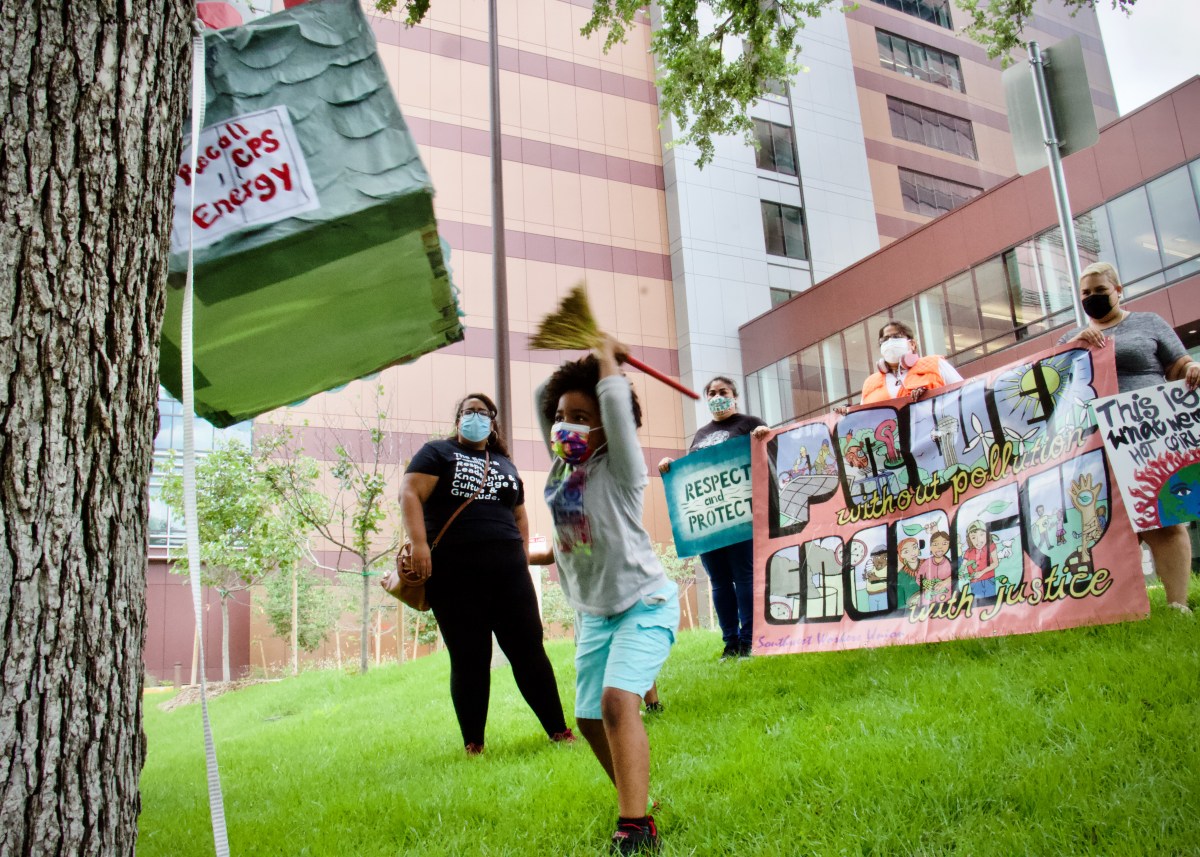
Since San Antonio’s low-income residents would bear the brunt of the proposed rate increase, our Mayor and Council should demand a fair rate structure from CPS before any adjustment, argue two local scholars.
Meredith McGuire & Alfred Montoya

In America today we privatize profits and socialize losses. CPS Energy’s existing rate structure is how huge profits are created for businesses that use the most electricity at the expense of nearly all residential ratepayers. On Thursday, City Council is expected to vote on a 3.85-percent increase in electricity and gas rates, largely to cover weatherization that should have been done a decade ago to prevent losses like those in Winter Storm Uri. Until CPS Energy enacts fundamental rate reforms and commits to a significant climate response by 2030, Council needs to vote no.
CPS Energy’s current proposal asks for an across-the-board increase in electricity rates, locking in the many inequities built into the current rate structure. That rate structure is the problem, not the solution.
The proposed rates would further inequality by raising residential bills disproportionately while minimizing costs for those residents and businesses using the most energy. The biggest consumers pay much lower rates than the rest of us. All rates for profitable businesses should be high enough to pay their full cost to serve. [Utility retail customer bills have traditionally been based on the the cost to the utility to provide service, or the “cost to serve,” including labor and technology, acquiring/creating and transmitting energy to customers, which is divided by the total number of customers.]

The CPS Board unanimously approved San Antonio’s Climate Action and Adaptation Plan, but two and a half years later CPS is still refusing to commit to reductions of greenhouse gases by 2030, a milestone necessary to avoid the worst impacts of climate change. City Council has the authority to set policy requiring the rate structure to promote both significant reduction of electricity usage and investment in Distributed Energy Resources (DERs), like solar arrays and battery storage. These distributed systems are crucial for creating local microgrids that both supply energy and stabilize the grid during severe weather events.

CPS appears eager to embark on a costly transformation of Spruce 2 coal unit into a gas-fired power plant, ensuring more decades of greenhouse gas emissions. Is it prudent to borrow money to build a new fossil fuel-intensive power generation facility with a 40-year lifespan if a federally mandated price on carbon will almost certainly be in place long before 2040? Not accounting for that now leaves CPS at high risk of stranded assets and unpaid debt.
The City Council and the Mayor must not shirk their responsibility to the people of San Antonio. The City Council has the authority to hold our public utility accountable for failure to protect people from Winter Storm Uri. As Uri and many historic heat waves have shown: people die when they don’t have electricity to keep warm or cool.
Until there are significant reforms at CPS, City Council must reject rate-hike requests and insist CPS expand the weatherization of all older housing, especially in low-income neighborhoods.
To help protect our most vulnerable residents, Council should require CPS to grow their existing weatherization and energy efficiency efforts under the STEP (Save for Tomorrow Energy Plan) program. Council should also call for major changes in the Uniform Development Code to require all new buildings be highly energy efficient.
To better understand how CPS is doing business, Council must require CPS to reveal details (not just averages) about residential energy usage. There are three rates for residential electricity usage, but only one (RCE, Large-Use Residential Capacity Energy) is designed for rich residents who use inordinate amounts of electricity. Instead of a rate structure that promotes conservation and energy-efficiency, the RCE rate encourages heavy usage and waste. CPS justifies this by saying, in a recent presentation to the CPS Rate Advisory Committee: “The higher the use, the more likely a residential customer will cover the total cost to serve.” Councilmembers: Don’t let CPS hasten climate chaos with such backward thinking!
It is appalling that a special rate for wealthy residents using the most energy (at $0.0450/kWh) is much lower than basic RA (Residential All Electric) and RE (Residential Electric) rates for the rest of us(at $0.0691/kWh). Basing the “cost to serve” on average amounts of energy use rewards the highest users with unfair breaks while forcing the more energy-conserving (and often low-income) customers to pick up the tab for those breaks. Since RCE ratepayers pay much less per kilowatt hour than others, all non-RCE customers are stuck subsidizing wasteful customers.
RCE ratepayers use thousands of kilowatt hours per month more than the average customer. Why does it matter? If all residential ratepayers dropped their usage below 1,500 kilowatt hours per month (kWh/mo), CPS could retire air-polluting Spruce 1 without needing any replacement generator.
In contrast to the CPS model, Austin Energy has an inclining tiered rate structure that rewards those using less than 1,000 kWh/month but penalizes those using over 1,500 kWh/month and 2,000 kWh/month.
During February’s deadly blackouts, some energy-intensive businesses on working circuits remained open and consumed lots of power through the crisis. That electricity was for producing profit. Council should require CPS to reveal details about amounts used by the heaviest demanding businesses (ELP-Extra Large Power and SLP-Super Large Power), including identifying which businesses were on open circuits during blackouts and for how long. Those businesses must pay their proportionate share of CPS’s outrageously high winter storm bill. No residential ratepayers should have to subsidize those highly profitable businesses.
Council must ask pointed questions: Exactly why is CPS’s current rate hike for the largest industrial users (the SLP class) so miniscule—a mere 16 percent of the cost it takes to provide them service? Under the current proposal these heavy users would only pay for only 30 percent of that cost. See below.

Why have those profitable businesses been paying such tiny amounts of their costs all along when struggling residential ratepayers are going from 40 percent to nearly 70 percent under the proposed rate hike?
Why is our public utility hurting residential ratepayers with greatly increased fixed charges, while profitable SLP business customers are not even providing many good jobs?
City Council has the authority to demand reforms to CPS Energy’s rate structure and hold CPS accountable. Make CPS deliver on its own motto: “People First.”
To keep SA’s people first, CPS must provide essential quantities of energy necessary to keep people safe, alive, and well during extreme weather events. Essential utilities must be available to all households, regardless of their ability to pay costs.
The City Council should postpone approval of any part of CPS Energy’s requested rate increase until CPS:
- takes responsibility for its failure to adequately protect the residents of this city and cover their existing needs through by cutting frills like travel, entertainment, and executive perks;
- limits proposed residential ratepayers’ rate hike (including fuel adjustment charges) to usage greater than 1,500 kWh (kilowatt hours) per month, and requires profitable businesses using the most energy to pay at least 90% cost recovery;
- cooperates immediately in a thorough Rate Allocation Review with a recognized outside, impartial, and Council-approved organization with experience shaping rate structures that protect vulnerable low-income communities, followed by an Interim Rate Case;
- commits to a fully equitable rate structure that promotes significant climate action, to be put into effect by January 2023;
- commits to beating the City of San Antonio’s greenhouse-reduction goals of nearly half of energy-related emissions by 2030.
-30-
Dr. Meredith McGuire, now retired, taught sociology and anthropology at Trinity University. Dr. Alfred Montoya was born and raised and currently resides on the city’s West Side. He is a medical anthropologist and associate professor at Trinity University.
Editor’s Note: High residential users of the RCE class described above also pay a per-kilowatt “demand charge” of $8/kW in the summer months and $3.80/kW the rest of the year. While this starts to narrow the gap between what the richest San Antonians pay compared to other residential users (particularly in the summertime), the gaps remain large. For instance, comparing the per-kilowatt cost for electricity used plus CPS demand charges included in two sample bills provided to RAC members recently showed a summertime savings for the RCE users of $176 for a summer month over a typical residential bill and more significant $1,259 undercharge (when compared with a typical residential user) for a non-summer month.
Like What You’re Seeing? Become a patron for as little as $1 per month. Sign up for our newsletter (for nothing!). Subscribe to our podcast at iTunes or Sticher. Share this story with others.








